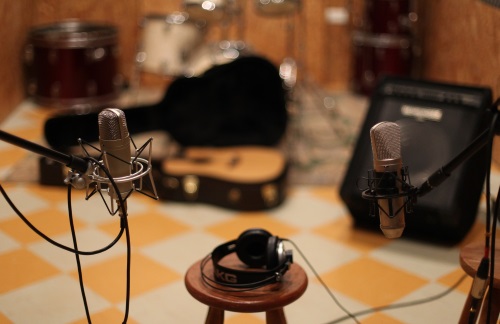
Click Tracks
Recognize that no human ever born stays exactly with the click at all times! I have worked with many drummers and they tell me that they can “push” or “lay back” on the click but are rarely “inside” the click for very long time periods. A drummer might complain that they don’t groove as well having to focus on staying with a click. Other drummers practice to click all the time and develop a need for it when recording.
If you have a track recorded with a sequencer, there is no choice but to overdub drums to the sequencer’s click or a drum machine track or loop. If you’re recording all at once, using a click will insure (more or less) that you could probably add MIDI sequenced instruments later.
One trick is to let the drummer count off and start the song listening to the click and then turn it off. Then, at least the song started out at an agreed upon tempo.
I leave the choice of click sound to the drummer. You can use a cowbell sound playing quarter notes or eight notes if the tempo is slow and/or there is an implied eight note feel. A fat, low-pitched cowbell sound can be very loud in the drummer’s phones and not hurt too much.
I’ve seen drummers request both the cowbell and a simple drum machine loop just for feel and vibe. I give them whatever they want because they have to work with it! Generally the rest of the musicians DO NOT want to hear the click. Finally, on playback, check that the click is not leaking to the room or drum mics.
If you’re overdubbing a drummer and there is no click or the only tempo reference are pre-recorded musical instruments, your drummer will play more freely, but you may have to fix downbeats and areas where things come unglued. It may be necessary, at times, to play only the single instrument that represents the pulse of the music and that pulse may be represented by other instruments at differing places in the song.
Strict tempo requirement is one of two stigmas we inherited from 1980s computer/music making; the other is the strict intonation made possible by the digital tuner and quartz-locked synthesizers. Now, music consumers (even though they don’t realize it) are much more aware of tuning and timing than ever.
Expensive vs. Cheap Mics
There is no doubt about it: expensive mics sound great! Expensive condenser microphones are investments in your recording future. No matter what comes and goes in musical trends or recording gear, you’ll always need microphones.
I get e-mails about using less expensive microphones when recording and people wonder if they are good enough for the task. If you can, rent some expensive microphones for your session just to see the differences. I think you’ll be surprised when and where you can and can’t hear the money.
I once recorded, as sort of an experiment, the entire drum kit for a song using only Shure SM57s. The producer and I called it the $100 drum sound. The album, by Daryl Hall and John Oates, was a big hit and the song “Sara Smile” was a top 10 record. We received more phone calls than anything else asking how we got this cool drum sound. What did we use? Where did we record them?
Moral of the story: use whatever mics you have. Keep them in good shape by putting them away and not abusing them with cigarette smoke, moisture and rough handling.
Leakage
If you’re recording everyone at the same time and there is leakage, it is not the end of the world. Actually the overall track might sound better WITH the leakage than cleaned up.
Rather than thinking that you are “stuck” with not be able to replace some of the musician’s tracks later because they leaked on tracks you wanted to keep, you make a commitment to the band’s performance and resolve that the track is great or as best (given all circumstances) as it is going to be.
I personally think, as a band, going into a live tracking session thinking that any of it can be replaced is self-defeating, because there will be no urgency to achieve a great performance. It puts a sense of purpose and responsibility on all involved including the engineer and producer to be a part of this super effort.
If you feel that recording together is a good idea but want to reserve the ability to fix it later, just make sure nothing leaks, that’s all!
Leakage can work for you. In my early tracking days, I would place the grand piano right next to the drummer. People would say “wow you are going to get a lot of drum leakage being so close.”
Fact is, I used very thick and dense gobos or baffles and blankets to cordon off the piano from the drums. Sure, I got a little low frequency drum leakage into the piano mics, but since the two instruments were only about six feet apart, the time delay in the leakage was very short and only added to the drum sound.
Moving the piano further away would have increased the delay of the leakage and washed out the drum sound. Putting all the musicians close together is always a good idea anyway.
Recording rhythm tracks requires a lot of preparation and planning. With precise ideas on exactly how you want the session to proceed, you’ll be ready for a good time capturing great performances.
Image credit: Gavin Whitner
